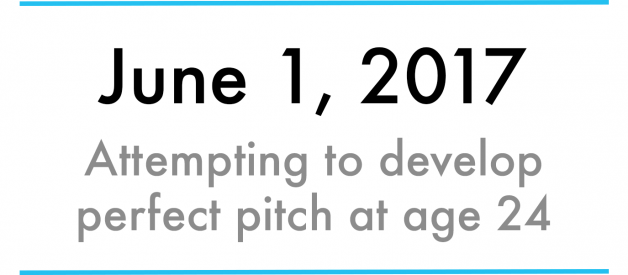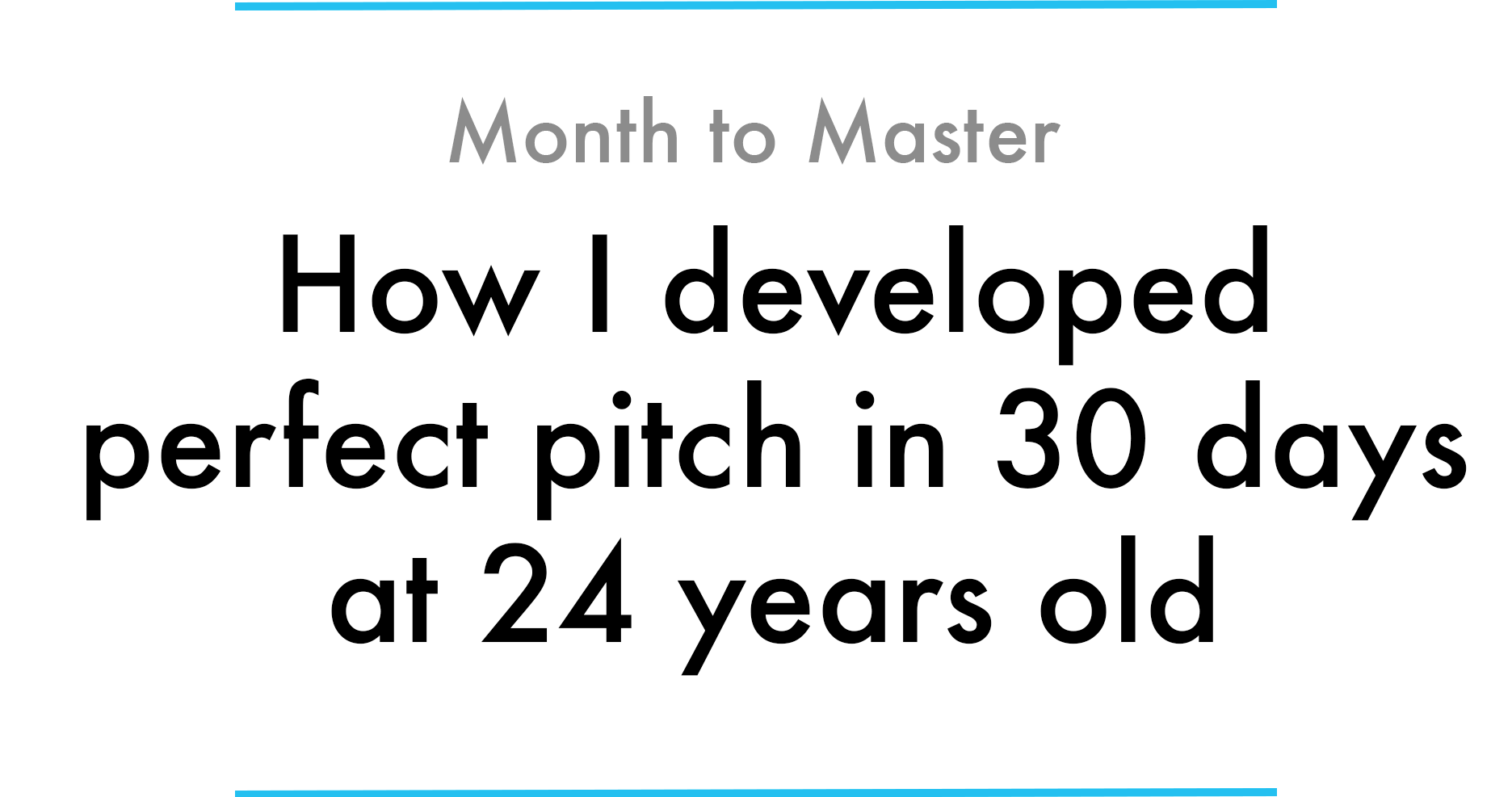
On June 1, 2017, I asked myself the question: With only one month of practice, can I develop perfect pitch?
In particular, can I correctly identify 20 consecutive, randomly-generated musical notes without a reference tone?
On June 27, 2017, after 16 hours of practice, I found out that the answer was yes.
During the month of June, I documented my entire learning process in a series of 30 daily blog posts, which are compiled here into a single narrative. In this article, you can relive my month of insights, frustrations, learning hacks, and triumphs, as I strive towards monthly mastery.

Today, I start a new month and a new challenge: With only one month of practice, can I develop perfect pitch?
According to Wikipedia, perfect pitch is a ?rare auditory phenomenon characterized by the ability of a person to identify or re-create a given musical note without the benefit of a reference tone?.
In other words, if someone went to a piano and played a randomly selected note, someone else with perfect pitch, whose back is turned to the piano, could instantly and correctly identify the note being played (using the 12-note musical alphabet: A, Bb, B, C, Db, D, Eb, E, F, Gb, G, Ab).
My goal this month is to acquire this ability. In particular, I?m challenging myself to correctly identify 20 consecutive, randomly-generated musical notes without a reference tone.
I will likely test my perfect pitch abilities in two ways: 1. Using a computer to generate the notes, and 2. Using another human and a piano to generate the notes.
I think it will be easier to demonstrate the authenticity of my abilities via the computer, but I think it?s more dramatic with another human, so I?ll do both.
Importantly, my goal is to be able to instantly (or almost instantly) identify the note being played. I want to minimize any sort of mental computing as much as possible.
Interestingly, according to this NIH research paper on perfect pitch (which, in the literature, is called Absolute Pitch or AP), perfect pitch doesn?t actually need to be perfect:
Individuals who possess AP are able to identify the pitch class, i.e., one of the 12 notes of the Western musical system, e.g., C, D, G#, of a sound with great accuracy (varying between 70?99%, depending on the task, as compared to 10?40% for non-AP individuals, Takeuchi and Hulse, 1993).
Nevertheless, I?m aiming for 100% accuracy for this month?s challenge.
My starting point
The main tool I?ll be using for training is tonedear.com (which I originally read as ?Tone Dear?, later realizing that it?s most likely ?Toned Ear?).
Using Toned Ear, I set this month?s baseline by attempting to identify 20 consecutive computer-generated notes. I successfully identified 7 out of the 20, or 35% (which falls on the upper side of the 10?40% non-AP range mentioned above). In other words, I most definitely do not have perfect pitch.
You?ll notice, in the video, I sometimes have a general sense of which area the note is in, sometimes I?m completely lost, and sometimes I miraculously pick the right note (mostly aided by its close relationship to the previous note).
Not the best audio, especially for an audio-centric challenge. I need to figure out a better recording setup.
While 35% is certainly far from perfect pitch standards, it?s not a horrible starting place. I suspect I have an advantage due to my musical training and general knowledge of music theory (versus someone without any musical background).
My chance of failure
During the past seven challenges, even though they weren?t easy, I was reasonably convinced that I would succeed. This challenge I?m way less confident, which stems from the fact that what I?m attempting to do has never officially been documented before.
Here?s what the NIH paper explains?
Training that begins after the age of 9 very rarely leads to AP [perfect pitch], and there are no known cases of an adult successfully acquiring it (Brady, 1970; Ward and Burns, 1999; Levitin and Rogers, 2005).
1 in 10,000 people have perfect pitch, and none of those people have developed it in adulthood (at least, on record). So, this is going to be a bit of an uphill battle.
Nevertheless, I?m still excited for the challenge. I have the same type of self-centric optimism that every lottery player has (?It just feels like I?m going to be the one who does it?).
So, this should be interesting?

As I explained yesterday, this month?s challenge is to correctly identify 20 consecutive, randomly-generated musical notes without a reference tone, effectively demonstrating perfect pitch.
In order to develop perfect pitch (which I don?t have, as demonstrated yesterday), I?ve devised a three-part approach:
Part 1 ? Develop ?Relative Pitch?
The first part of my plan is to develop relative pitch, which Wikipedia explains like this:
Relative pitch is the ability of a person to identify or re-create a given musical note by comparing it to a reference note and identifying the interval between those two notes.
In other words, to demonstrate relative pitch, I would first listen to a reference note (for example, a C), then listen to another unidentified note, and finally try to identify the second note based on its relationship to C.
Using a reference note to identify a second note (i.e. relative pitch) is much easier than recognizing a single note without any reference (i.e. perfect pitch). In fact, relative pitch is fairly teachable, and most serious musicians have some semblance of relative pitch as a result of their musical training.
I?ll talk more about the common methods for developing relative pitch in future posts, but, in general, this is a skill that I should be able to acquire.
Part 2 ? Internalize a reference note
The difference between perfect pitch and relative pitch is that relative pitch is aided by an external reference note. Thus, to transition to from relative to perfect pitch, I?ll need to figure out a way to remove the reference.
Here?s my plan?
If I can mentally produce a consistent reference note (that I can create and play quietly inside my brain), I should be able to combine this mental reference with my relative pitch skills to identify any other musical note without an external reference point.
I?m not exactly sure what it means to internally generate a reference tone, but I also think this is doable.
Part 3 ? Practice (to reduce computation time)
If I just complete parts 1 and 2, the result won?t look very much like perfect pitch. Instead, after a note is played, I?ll sit there, hum to myself, do a quick mental computation, and then guess which note is being played.
While I may need this computation time in the beginning, my hope is that, in time, I can get faster and faster, until I?m not actually consciously thinking of my mental reference note at all.
Once the reference note becomes part of my subconscious, and my relative pitch skills become consistent, I should be able to instantly recognize any note being played without any mental computation.
I?m not sure if this counts as genuine perfect pitch (due to the unconventional process), but the result is identical, so I?d say it counts.
I have no idea if this process will actually work, but it seems like the best possible plan.
I considered some other options, like trying to associate different colors with different notes in some fashion, and then, seeing if a random note would mentally trigger the associated color. (Effectively, I would try to become synesthetic).
This approach may be possible (after all, I did start having some weird synesthetic experiences while trying to memorize decks of cards back in November), but it seems less controllable. So, I?m going to stick with my three-part plan.
Tomorrow, I?ll begin the first phase of my training, and start developing my relative pitch?

Yesterday, I structured my pursuit of perfect pitch into three parts: 1. Develop relative pitch, 2. Internalize a reference note, 3. Practice to reduce computation time.
Today, I started on the first part: Developing relative pitch.
As a reminder, relative pitch is the ability to identify a musical note in comparison to a reference note. For example, if I first play a C on the piano, I should then be able to identify any other note based on its relationship to C (assuming I have relative pitch).
In music theory, this relationship is called an interval.
The most common way to internalize a new interval is to find a well-known song that features the particular interval and can thus be used to describe the interval. In other words, the hope is that, after hearing the interval, the related song is mentally triggered, and the interval can be identified based on its association to the song.
For example, the major second interval, which is the fancy name for the interval between a C and a D, is featured in the first couple notes of ?Happy Birthday?. Thus, with a little bit of practice, every time I hear this interval, ?Happy Birthday? is mentally triggered, and I can appropriately identify the interval as a major second.
Since I?ve decided to always use C as my reference note (for the rest of the month), I can forget about the fancy interval names and instead just use the note names: So, when I hear ?Happy Birthday?, I can always think D.
In a similar way, I can assign other popular songs to the other intervals/notes.
For example, the interval from a C to an E is featured within the song ?When The Saints Go Marching In?.
The interval between a C and an F is featured within the song ?Here Comes The Bride?.
C to G is featured in the ?Star Wars? theme song.
C to A is featured in the NBC chimes.
I haven?t yet found a song that features the C to B interval (although, I seem to be able to recognize this interval without a song).
I also haven?t found songs for the intervals between C and the notes outside of the key of C (since these intervals are less used in popular music). This includes C to C#, C to Eb, C to F#, C to Ab, and C to Bb.
Before I spend more time looking for these mnemonic songs, today I figured I should first test out the effectiveness of the ones I?ve already selected.
Thus, I spent some time on Toned Ear (the perfect pitch training website), practicing all the intervals between C and the other natural notes (i.e. the notes in the key of C).
So far, this song-related approach seems to be effective and honestly not so hard to master. I suspect these are the easy intervals, but still? I?m happy with my progress.

Yesterday, I began practicing my relative pitch, which is the first part of my three-part plan for developing perfect pitch.
While I still have significant work to do on this part, today, I continued on to the second part of my plan. I figured it?s best to train each part in parallel.
For this part, my goal is to be able to consistently produce a reference tone. In other words, I should be able to, at any time, without any assistance, sing the note C.
Yesterday, I was practicing my relative pitch in relation to C, so it also makes sense to choose C as my internally-produced reference tone. (Again, the idea is that? if I can always identify C, and can always identify any other note?s relation to C, I should be able to identify any note).
Consistently producing a C seems to be the hardest part of this month?s challenge. So, if I can figure this out, everything else should theoretically fall into place (I hope).
At first, my plan was to use my personal physiology as a way to consistently find the same note. In particular, I was thinking that I could use either the lowest note I can sing, or the highest note I can sing before my voice breaks into falsetto, as my reference tone.
There are two problems with the physiological approach: 1. Neither the lowest note or the breaking point note are a C, and 2. Even if they were, my vocal range would likely change day-by-day.
The physiological approach would have been great though, given that I wouldn?t have to train in any capacity ? I would just use the built-in features of my body (hence, why I gave it some consideration). But, it seems that this isn?t an option.
So, here?s my actual plan: I need to find a song that?s in the key of C, that starts on the note C, and that I wouldn?t mind listening to hundreds of times.
Then, I need to listen to the song over and over again, until I can start singing it, in the correct key, consistently from memory. This seems like something that?s trainable.
If I can consistently find the starting note of that song, which will be a C, I?ll have my reference tone ready to go, and part 2 of my overall plan will be complete.
For now, I?ve chosen the song ?Changing? by John Mayer, which starts on a low C, and then proceeds up the scale in the key of C. The song seems perfect for what I need.
Now, I just need to commit to listening to this song repeatedly until it becomes stuck in my head forever.

Two days ago, I started searching for song-based mnemonics that I could use to more easily identify the intervals between C and all the other notes.
At the time, I had identified five mnemonics that represented all the intervals in the key of C (other than the interval between C and B).
Today, I finished selecting mnemonics for all twelve intervals (with the help of a guide that Kev recommended to me).
Here are the songs I?m using as mnemonics (to remember each note in reference to C):
C ? The reference tone
C# ? Jaws
D ? Happy Birthday
Eb ? Georgia On My Mind
E ? When the Saints Go Marching In
F ? Here Comes The Bride
F# ? The Simpsons
G ? Star Wars theme
Ab ? We Are Young
A ? NBC Chimes
Bb ? Star Trek theme
B ? Take On Me
With these mnemonics established, I went back to Toned Ear to practice.
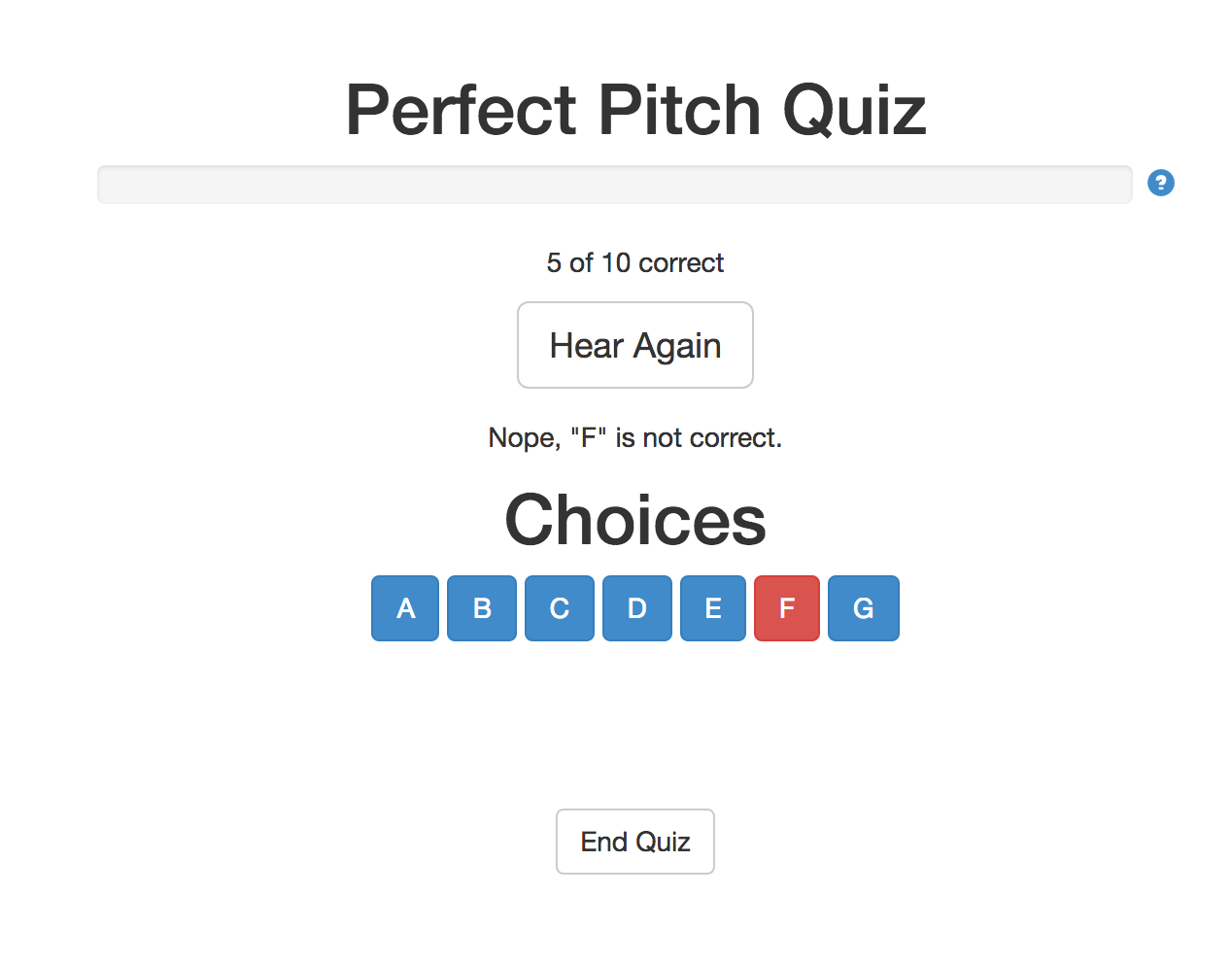
During my session, to simplify things for now, I continued focusing just on the notes in the key of C.
I very quickly came across a bit of a problem though: Whenever the played note was higher than the C reference tone, I could easily apply my mnemonic and guess the note correctly. However, my mnemonics didn?t work in the other direction ? If the played note was lower than the C, I was essentially guessing blind (or deaf?? Tone deaf?? I?m not sure what the auditory equivalent of this expression is).
I?m not particularly surprised by this finding. In fact, I was aware that I would eventually need to learn my intervals in the downward direction (my mnemonics only work for intervals in the upward direction right now).
However, this finding did get me thinking? Shouldn?t I want to learn each note in an octave-invariant kind of way? In other words, if my end goal is perfect pitch, not relative pitch, shouldn?t I determine some method where each note is perceived consistently regardless of the octave it?s played in?
I shouldn?t have to learn ?This is what a Bb sounds like when it?s a high Bb? and ?This is what a Bb sounds like when it?s a low Bb?.
A Bb should always just be a Bb.
With my current approach, I?m not sure that I have this ?octave-invariant? luxury, so perhaps this isn?t the right approach after all.
I feel like I could easily get sucked down the rabbit hole of relative pitch, which may actually take me further and further away from perfect pitch.
I need to make sure I?m using relative pitch as a crutch to get more comfortable practicing straight-up perfect pitch, and not as a short-term replacement goal.
I will likely want to remove my reliance on the relative pitch mnemonics sooner rather than later (and just use them to get me going).
Then again, if I remove the mnemonics completely, I?m not sure how scientific my approach can be? other than just repeatedly trying to identify notes over and over again on Toned Ear.
I?m a bit unsure which direction I should go. So, for now, I?ll continue to move generally forward, assess where I?m at, and refine my approach along the way.

For the past couple days, I?ve listened to the song ?Changing? by John Mayer about 12 times.
As I explained two days ago, my hope is that, if I listen to the song enough times, I?ll be able to sing it, in the correct key, completely from memory, whenever I want. Then, since the song starts on C and is in the key of C, my brain will be primed with C as its reference tone, and I?ll theoretically be able to use my relative pitch abilities to identify any other musical note.
I?m not sure how many times I?ll need to listen to the song before it?s fully internalized, but it?s definitely more than 12.
In fact, since the song is 3 minutes and 35 seconds long, if I wanted to listen to it 100 times, I would need to dedicate six hours to doing so. I?m not sure 100 listens will be enough, but I?m definitely not ready to devote this kind of time.
Plus, I?m not sure it?s necessary to listen to the entire song anyway. All I really care about is the first few seconds, which establish the reference tone and key.
Thus, I decided to chop up the song, and make a seemingly more optimal audio track. This track is 12 minutes and 42 seconds long, and features the first 17 seconds of the song, followed by 7 seconds of silence, followed again by the first 17 seconds of the song, followed by 7 seconds of silence, and so on? 32 times.
Here it is (I used YouTube for hosting, but it?s just audio)?
Using this new track, I can listen to the relevant part of the song 100 times in around 40 minutes, where 15 of those minutes will be silence.
Arguably, I could have made the periods of silence shorter, but I?m actually worried that I may have made them too short: I?m trying to use the periods of silence to build anticipation, which I think is the most important part of the training.
Let me explain?
If you?ve ever listened to the same album of songs over and over again (or the same playlist), where the songs are always played in the same order, then you may have experienced the phenomenon where you start anticipating the next song before it even starts.
The end of the first song acts as a mental trigger for the next song.
In the same way, I?m hoping to develop this kind of anticipation for the selected 17-second clip from ?Changing?. By adding slightly more-than-necessary silence, I?m giving my brain the space it needs to ?prepare? for the upcoming audio.
After all, eventually, when I?m testing my perfect pitch, I don?t want to consciously think about ?Changing?. Instead, I just want to activate the mental pathway that knows how to anticipate and prepare to hear ?Changing?.
In other words, I want to be able to instruct my brain to shift my mental reference frame into the key of C whenever I want.
I?m just using ?Changing? and the audio track as my training mechanism.
I?ve also put together a second track that I plan to use for assessing my ?prepare for the key of C? mental abilities (although, it may also help with training).
This track is 5 minutes and 30 seconds long, and features twelve copies of the 17-second clip from ?Changing?, with 10-second spaces between each of the copies.
However, within each space, I play a series of piano chords in an attempt to confuse my brain. For example, in the first space, I play four chords that resolve to a C#, attempting to shift my mental reference into the key of C#.
The trick then is to overpower this natural urge, retrigger the ?prepare for the key of C? pathway, and hopefully properly anticipate the 17-second clip from ?Changing? in the correct key.
In the other spaces, I play chords that resolve to each of the keys, starting from C#, then D, then Eb, and so on, all the way up to B.
Here it is?
With these two audio tracks, I should be able to more effectively train my brain?s reference tone abilities without having to listen to all 3 minutes and 35 seconds of the song every time.

In the past week, I?ve identified my main training tools and objectives with each.
Now, I need to find ways to consistently integrate these tools and practice methods into my life and distributed throughout my day. I believe that, in order to have any chance of acquiring perfect pitch, I must fully immerse myself in the process.
Of course, complete immersion can be challenging, given that I have a full-time job, a longish commute, and other daily responsibilities. The trick, then, is to make my daily practice habits as effortless as possible.
So, here?s what I?ve come up with?
When I leave my apartment in the morning (my first daily trigger), I start the 12 minute and 42 second ?Reference Tone Trainer? audio track that I created yesterday. Not-so-coincidently, my walk to the train station takes exactly 12 minutes and 42 seconds, so I board the train as the track finishes.
Finding a seat on the train and sitting down is my next trigger: At this point, I open up Toned Ear, and spend the next 20 minutes or so playing the ?Perfect Pitch Game?. (This is by far the best part? It?s a highly addicting game).
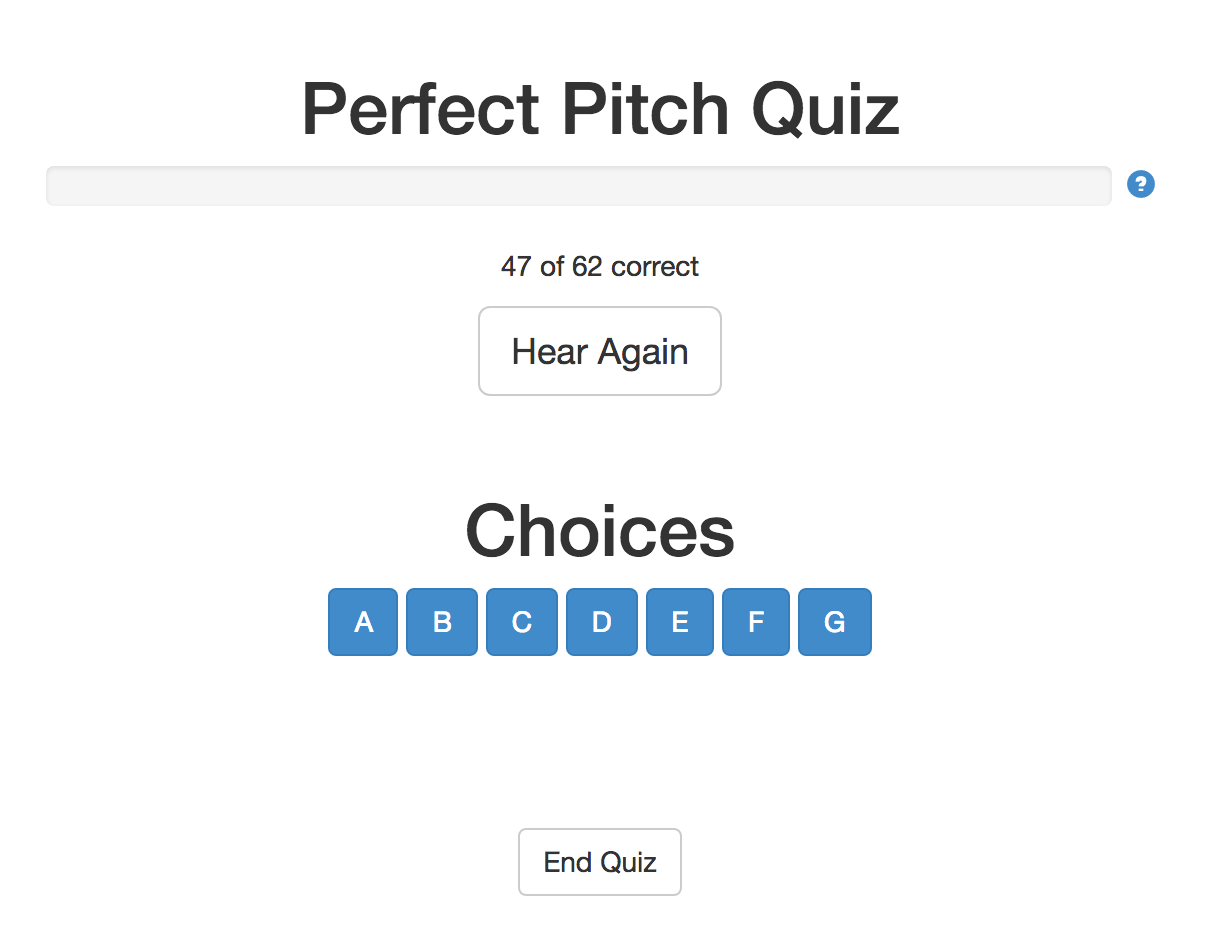
Then, once at work, I need to focus on work.
However, I?ve created two triggers that help me spend a few seconds here and there practicing during the workday.
Firstly, I made the wallpaper of my lock screen the album art for ?Changing? by John Mayer (which is the song I?m using to establish my mental reference note).
Every time I check my phone, I see the trigger and attempt to quietly sing the first note of the song to myself, which should be a C.

I then use the Perfect Piano app to play a C and check my accuracy.
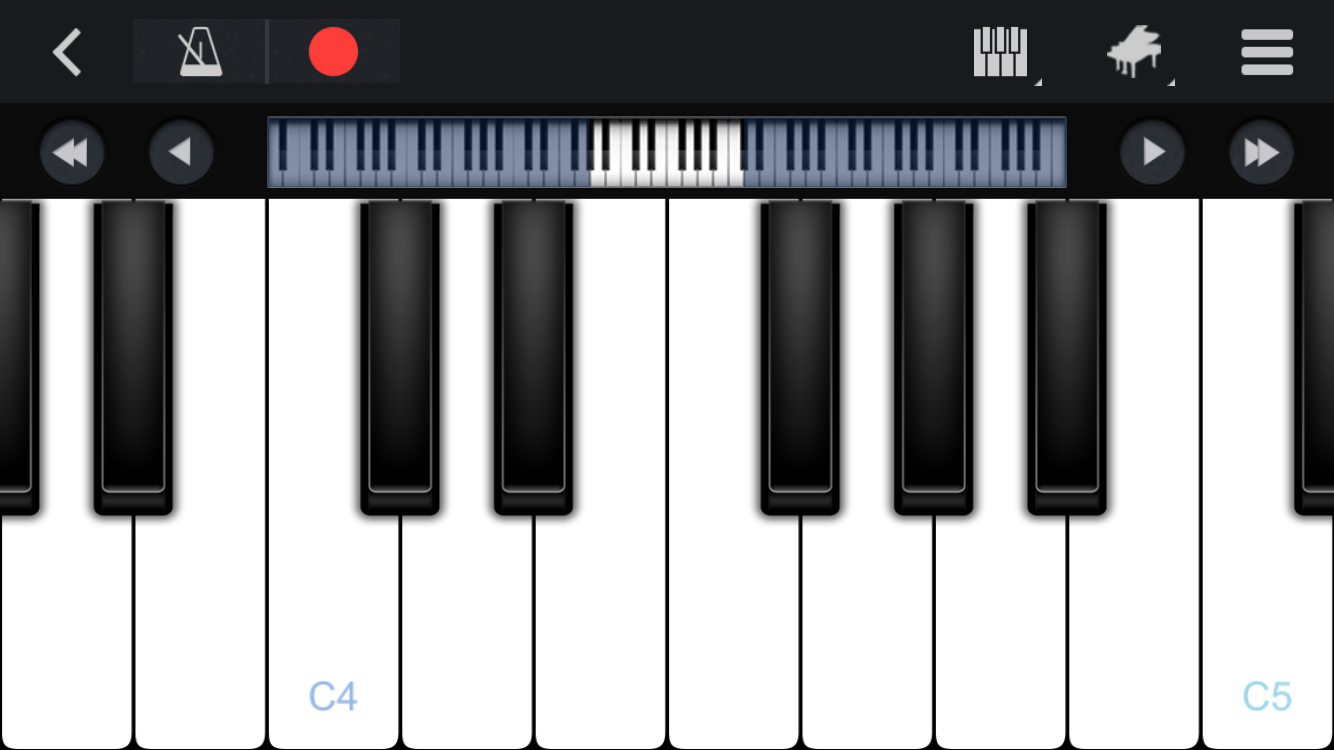
The second trigger I?ve set up is an hourly reminder via IFTTT.
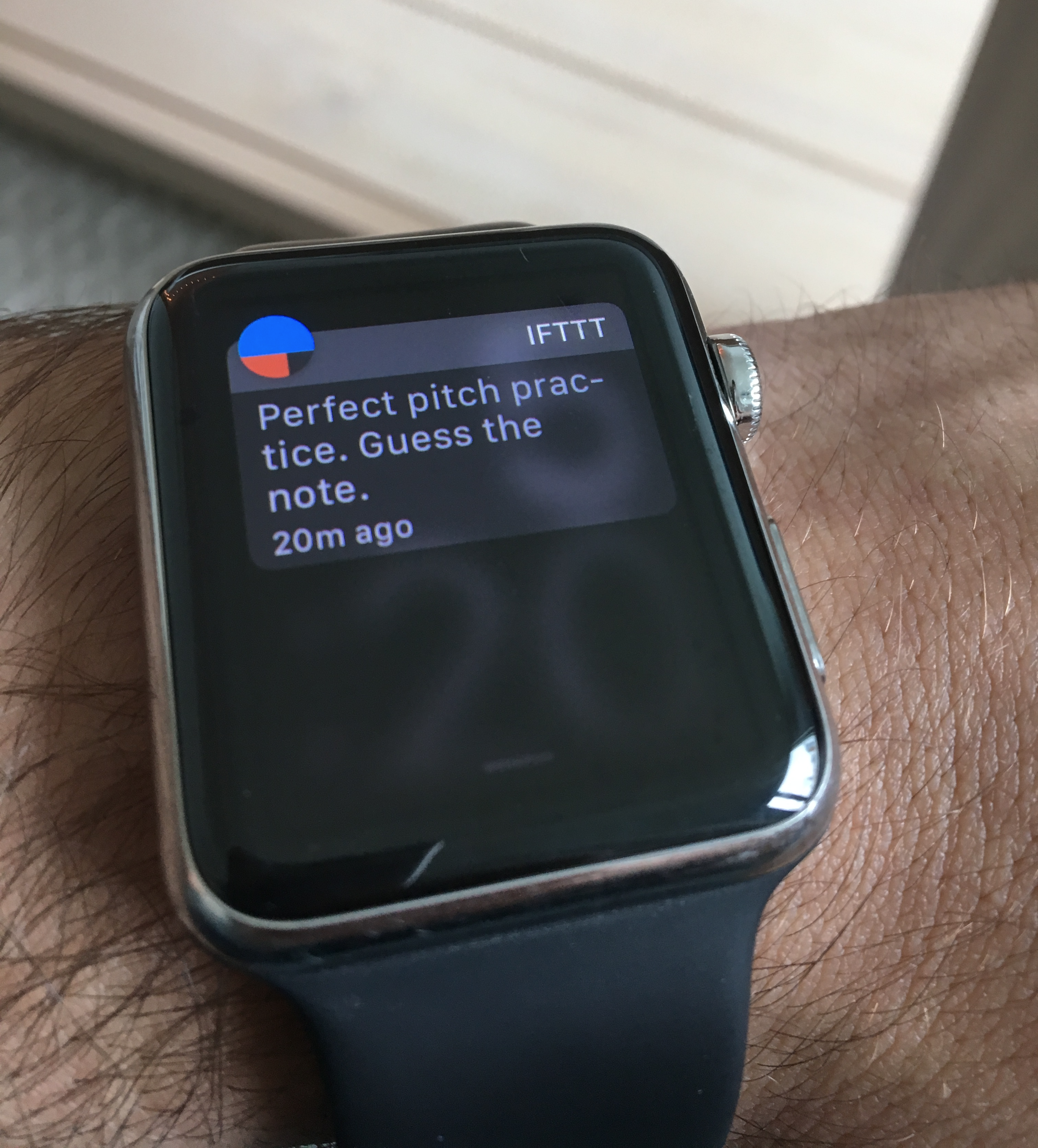
On the hour, after seeing the notification, I open Toned Ear and try to guess the very first note of the quiz.
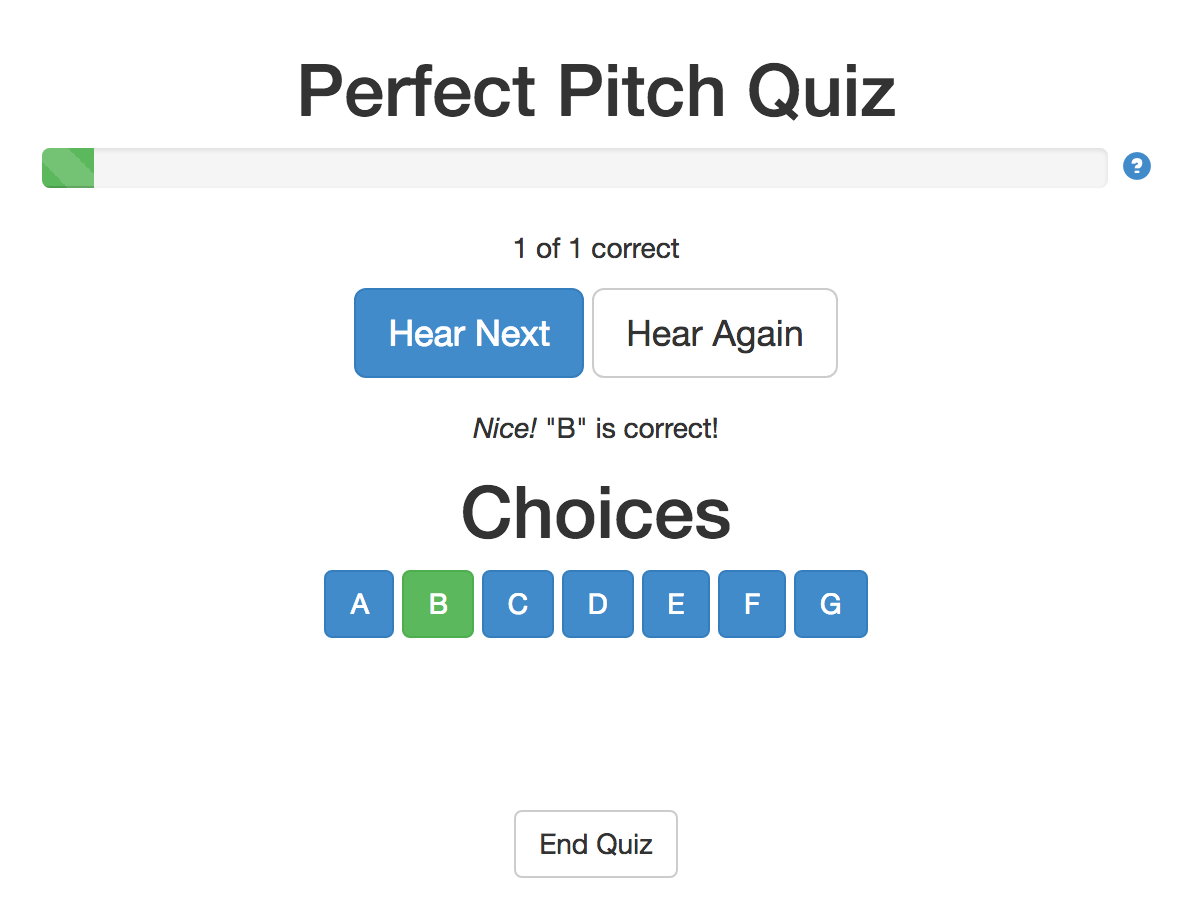
This is one step more challenging than singing the C: In this case, I need to set my mental reference frame to C, and then interpret the first note in relation to this reference frame.
Sometimes, I?ll be in the middle of work when I receive the notification, and, in those cases, I won?t interrupt myself. However, typically, on the hour, I?ll be in transition between meetings, so it?s a perfect time to guess a single note.
Finally, on my commute back home, once I get on the train, I spend another 20 minutes playing the extended ?Perfect Pitch Game? on Toned Ear.
For the next week and a half, I?ll continue training via this routine (unless I hit a wall and need to re-optimize). After that, I?m traveling for the rest of the month, so I?ll need to reestablish a routine at that point.

Throughout the Month to Master project, I?ve used certain challenges as excuses to do things I?ve wanted to do for a while.
For example, I used the fitness theme of Backflip Month to make a change to my diet. I used Rubik?s Cube Month to justify creating cube-inspired art. And I used Hebrew Month to read/think a lot about technology and the future (in preparation for my Hebrew conversation on these topics).
This month is music-themed, so it was the perfect excuse to go see a concert? Thus, last night, I went to see Vulfpeck (currently one of my favorite bands) live at The Fillmore in San Francisco.

Vulfpeck?s style is somewhere between old school funk, soul, and jam band. They put on an amazing show, and while I?m not sure it helped with my perfect pitch, I?m very glad I went.
This is the part of the post where I?m supposed to recommend my favorite Vulfpeck songs, so you can check them out if you?re interested. They have a pretty eclectic mix of songs, so I?m not exactly sure what to choose?
I?m just going to leave it up to the band: When they went on Late Night TV, they played their song ?1612?, which means they must think it?s a decent gateway drug to their stuff.
My personal favorites in no particular order include: Animal Spirits, Outro, Conscious Club, Cory Wong, Game Winner, Wait for the Moment, A Walk to Remember, and Back Pocket.

It?s nine days into this month?s challenge, so it?s probably time to share an update on my progress.
For the past week, I?ve focused on improving my pitch identification abilities within the key of C, and, today, I perfected this skill: In the below video, I identify all 60 of the 60 notes that are played.
Based on this video, it may seem like I?m more than halfway to my perfect pitch goal. After all, I can consistently identify 7 out of the 12 musical notes.
But, in reality, I?m still very far from having perfect pitch.
Let me explain?
When all the notes are in one key (in this case C), it?s very easy to maintain the mental reference frame of the key. As a result, it isn?t too challenging, with some practice, to learn each note?s color within that reference frame.
However, once additional notes (that live outside the key) are added, these new notes tend to warp my mental reference frame, challenging my ability to maintain a consistent reference tone.
For example, I tried to introduce a Bb today, but, upon doing so and hearing the Bb, my brain shifted into the key of F, completely abandoning my C reference frame. This is because Bb is in the key of F, but not in C, so my brain tried to make sense of the new tonal information and, as a result, reestablished a new, undesired reference frame based around F.
Thus, for the rest of the month, I?ll need to figure out how to integrate the remaining out-of-key notes into my repertoire, while preserving my mental reference frame of C.
I?m not exactly sure the best way of doing this yet, but at least I have a steady foundation within the key of C to build on top of.

Yesterday, I demonstrated my ability to consistently identify the notes within the key of C, presumably validating my training approach.
However, after trying to extend this approach to the notes outside of the key of C, I immediately started to struggle. In particular, once I introduced out-of-key notes, I found it nearly impossible to maintain a steady mental reference frame: The musical key of my brain continued to shift as it attempted to make harmonic sense of the most recently played notes.
As a result, I quickly became musically disoriented, losing all ability to identify pitch.
Clearly, I need to figure out a better way to maintain my mental reference frame of C.
?Resolve, not solve?
To combat this problem, I?ve developed a new way to hear and interpret each note.
Previously, I was trying to solve the following musical equation: Given that this note is a C, what is this other note?
In other words, I started my ?mental calculation? from C, and then tried to work my way from there to the note being played.
For example, if I was trying to identify an F, I would first mentally play a C, hear the F, work out the tonal relationship (based on my mnemonics), and then label the F as ?an F? if successful.
Here?s what that would sound like in my head?
However, after doing this exercise, my brain would find itself settled on F (since this was the last note I heard), priming my brain to relate the next note to F, instead of C.
It?s not too challenging to overcome this priming if the note being played is in the key of C. If it is, I can usually find my way back to C, preparing myself for the next note.
However, if the last-played note is outside of the key, I seem to struggle to find my way back.
Thus, rather than trying to solve my way to the note, I?ve instead decided that I will try to resolve my way back to C.
In other words, when I hear a note, rather than layering it on top of a C for comparison, instead, I want to try to hear how that note resolves back to a C.
In this way, I will learn to identify each note based on the way it yearns for musical resolution towards C. And, at the same time, because I?m resolving each note to C, I will be able to more easily maintain a consistent tonal reference frame.
So, using this new ?Resolve, not solve? method, I would hear an F in the following way?
Similarly, rather than hearing a D like this:
I would hear a D like this:
Rather than hearing an A like this:
I would hear it resolve like this:
The above resolution of A isn?t necessarily the resolution of A. It?s just the one that I hear.
Anyway, this method becomes particularly important when introducing notes outside of the key of C. For example, here?s how an Ab would sound using the previous method:
And, here?s how I hear it with the new ?Resolve, not solve? method:
As a final example, here is how I would process an Eb previously?
And, here?s how I hear it resolve to C:
While I still need significantly more practice with this new method, so far, it seems very promising.

Yesterday, I figured out a better way to identify musical notes, allowing me to maintain my mental reference frame even when the particular notes drift out-of-key.
Today, I used this technique to introduce the notes Bb and Eb into my training, which I spaced out over four 15-minute sessions.
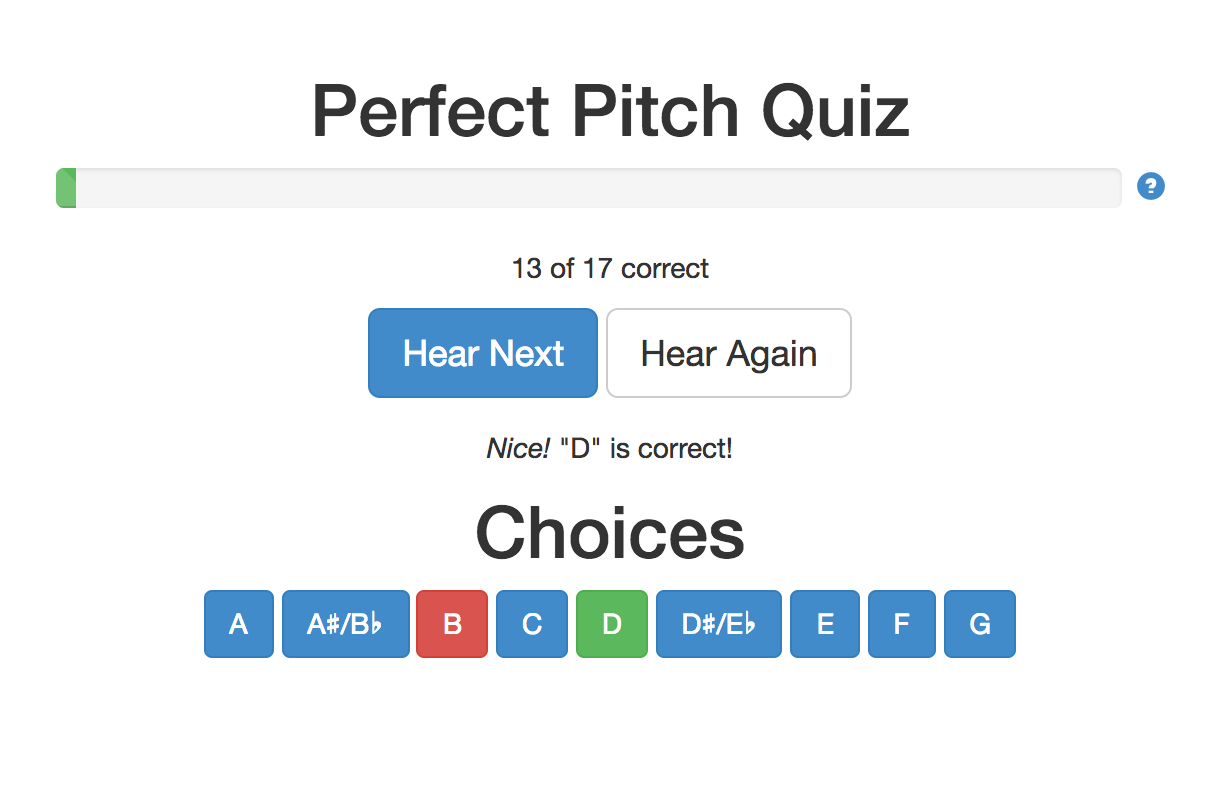
After completing these four sessions, I realized two things: 1. I?m getting better, and 2. I?m getting worse.
I?m getting better
Once I?m in the groove of identifying notes, I?m finding it easier and easier to maintain my mental reference frame and consistently interpret the sequence of notes correctly.
Based on my pace of progress, it seem that I?ll actually be able to learn the remaining notes, and maintain my level of accuracy. It?s going to take a lot of practice, but it now seems reasonably in reach if I work for it.
I?m getting worse
Although my accuracy within the practice session is improving, my accuracy at the beginning of each session is worsening. In other words, I?m finding it harder and harder to identify the very first note of the training session.
In the past couple days, I?ve been relying less on the song ?Changing? to establish my reference frame, and instead, I?ve been simply relying on my continuous practice within the key of C.
Basically, since I?ve only been practicing in the key of C, and continue to return to my practice throughout the day, I?ve found it easy to keep my brain in C from session to session.
However, now that I?m starting to introduce notes outside of the key, it seems I?ve lost this luxury.
Part of me thinks that, if I continue to improve my key maintenance within these broader tonal sessions, I should eventually be able to regain this luxury.
The other part of me thinks that I should devote more time to independently training my mental reference frame.
I guess I?ll need to monitor this over the next few days, and see which part of me is right.

Today, I regressed (or, at least, that?s what I thought).
Throughout the day, I practiced identifying notes with very little success. It was almost frustrating how inaccurate I was.
I?m not sure if this was because of my poor night sleep last night, or just brain overload in general, but this was the first day where it seemed that I got unilaterally worse.
On the bright side, this kink in my linear progress makes for a more compelling narrative anyway, so I figured I would lean into it: My plan was to come home, film myself struggling, emphasize this struggle as a plot point, and move on to tomorrow.
Yet, something different happen.
When I got home, I opened my computer and headed to Toned Ear, ready to film my session. I decided, in order to really emphasis my struggle, I would enable all twelve notes as possible options, ensuring that I would flounder.
But then, through some kind of mystical alignment of the perfect pitch stars, I correctly identified 85% of the notes (17 out of 20).
While this was exciting, I was a bit disappointed: I was mentally prepared to write about today?s failure. This better-than-expected performance completely ruined my narrative arc.
So, I figured I would just film another session. After all, my first performance was probably just lucky.
But then? I identified 80% of the notes correctly. A slight dip (so I was getting closer? to being bad), but still, this performance was not going to serve my narrative.
Finally, on my third attempt, I was able to score a not-so-impressive 12 out of 20 notes.
So ignoring the first two sessions, I can finally paint the narrative that I was hoping for: I?m struggling, and I?m just not sure if I can pull myself together in the next few weeks. This is a serious uphill battle.
With the drama now out of the way, I can say, in all seriousness, that I?m quite excited by my results this evening. I truthfully struggled during the day, but once I was back in my quiet apartment, I was able to fully focus and perform at the edge of my training.
Clearly, I?m still inconsistent (and I was likely a bit lucky today as well? in terms of what I caught on camera), but the results are promising.
There?s some important commentary about the videos that I want to share, but I?ll save that for tomorrow.

Yesterday, to my surprise, I was able to correctly identify 17 out of 20 chromatic notes (chromatic = all twelve of the musical notes).
While this certainly demonstrates forward progress in some capacity, I don?t think it actually represents strong progress towards genuine perfect pitch.
To explain what I mean, I think it makes sense to share what was happening in my brain during the filming of the video.
First, here?s the video?
For the first seven notes, I?m able to maintain my mental reference in the key of C, and, as a result, I?m able to identify all seven without a problem: Bb, E, A, C, B, Eb, Ab.
Although I correctly identify the Ab, it messes me up ? I accidentally resolve the Ab in my brain as if it were an A, which means that I unknowingly shifted my mental reference frame down one note to a B (but I still think it?s C? In other words, I now think every note is one note higher than it actually is).
As a result, note #8 sounds like a B to me, but it?s actually a Bb, costing me my first mistake. Nevertheless, I sometimes confuse B and Bb anyway, so I didn?t think much of it.
However, then, note #9 sounds like a C to me, but is actually a B.
At this point, recognizing the pattern, I realize that my brain has shifted into the key of B, and that I need to do something about it.
Normally, during my non-videoed training sessions, I would sing the correct resolve from B to C, to reset my mental reference frame back to C. But, in the video, I choose not to sing (since this seemed like cheating), and instead, I decided to just ?pick the note that?s one lower than the one it sounds like?. (As far as perfect pitch is concerned, this also seems like cheating).
I should probably stop singing all together. I need to practice like it?s game time.
Anyway, after accepting B as the new reference tone, I proceeded to correctly identify all eleven remaining notes: F#, B, F#, E, Bb, Ab, A, B, Bb, Ab, Eb.
Technically, in the video, I incorrectly select F instead of E (bolded above). However, this was a genuine misclick. So, technically, in my mind, I actually identified 18 out of 20 notes (but, I didn?t want to get into this misclick excuse-making yesterday, so I decided to simplify the story and just stick with 17).
While I?m pleased with this performance, and quite happy that my mental reference only shifted once during the session, I don?t think this kind of behavior is exactly equivalent to perfect pitch.
No one with perfect pitch wakes up one morning and says ?Hmm? All notes seem a bit sharp today. Let me just correct for this by shifting all the names of the notes down by one.?
I mean, maybe this happens. I don?t know. But, it doesn?t seem likely.
More likely, someone with perfect pitch just hears a Bb, and says ?Oh, that?s a Bb?. Not because they have some sort of C reference frame, but because that?s what a Bb sounds like.
Interesting, I?ve noticed that the notes A and E are starting to take on this quality for me. Sometimes, during my practicing, my mental reference is shifting all around (and I?m trying to keep up), but then, an A or E is played, and I instantly just recognize them by sound. Not only that, but then my brain immediately shifts back into the key of C.
Other times, even A and E don?t sound like A and E. Still, occasionally, they are breaking through the relativeness and I can hear them just based on their musical color.
If only I could gain this power for all other notes, I?d be good to go.
I?m interested to see if this happens in time, or if I will need to continue playing the ?chase the mental reference tone? game.

Over the past couple days, I?ve noticed that I?m starting to identify certain notes without any mental computation: The note is played and I instantly know which note it is.
In fact, I almost always have an instant instinct for which note is being played. Sometimes, when my mental reference frame is shifting around, this instinct is wrong (since it?s grounded in a moving foundation). But still? The fact that I?m starting to develop this kind of instinct is promising.
And yet, occasionally, I?ll hear a note and have no sense of pitch, as if my tonal grounding is completely ripped away. With most notes, I?ll hear some kind of musical color or emotional quality, and yet, with these ungrounded notes, I?m completely lost.
Weirdly, though, there?s some good news: If I?m lost in this way (i.e. not registering any kind of musical emotion), the note is almost certainly (~95%) an F.
I?m not sure why this is the case, but, unlike all the other notes (which carry some kind of emotion), F typically sounds like nothing to me.
F is the absence of emotion.
This isn?t some sort of intense synesthetic response to F, nor is it the case where the resonant frequency of my brain is somehow transcendently related to 349.2 Hz (the frequency of F).
I?m just bad at hearing fourths (the interval between C and F).
This is surprising given that, in isolation, this is the easiest interval for me to sing (It?s just the first two notes of ?Here Comes The Bride?). And yet, when I introduce all the other moving parts, this interval somehow gets lost.
Nevertheless, slowly over time, my brain will hopefully learn to associate this emotionless response with the neuron that represents the note F. Then, the absence of response will eventually become the response.
Anyway? just a weird observation that I thought was worth sharing.

Three days ago, I surprised myself and scored an 85% on a 20-note perfect pitch test. This was exciting, but also detrimental to my progress.
Before taking this test, I was practicing my pitch identification abilities only on smaller groups of notes (not on all 12). So, while this one performance suggested that I was ready to ramp up my practice to full chromaticism (i.e. all 12 notes), I wasn?t actually ready.
As a result, for the past three days, I?ve made little progress, lost motivation, and built up a bit of frustration.
Here?s the problem: After my surprising performance on Monday, I abandoned my methodical practice schedule, and instead, just tried to replicate and improve upon my 85% score, jumping directly into 12-note practice sessions.
However, because I didn?t have a stable foundation for this, my performance during these sessions has been all over the place, and not particularly good.
I started comparing myself to this 85% baseline, which was a surprising outlier and not a fair assessment of my skills. Thus, everything else in comparison has seemed disappointing and a regression from where I was.
These feelings of ?moving backwards? have been unmotivating to say the least, and so, I?ve found myself avoiding practice over the past couple days (as not to continue piling on to this disappoint feeling).
Today, I was able to recognize that I?ve gotten ahead of myself, and have prematurely set my ?baseline? too high, resulting in this loss of motivation.
Tomorrow, I need to go back to the basics, work my way up from the bottom, and reassess where I?m truly at.
If I can remain disciplined, steady, and self-aware in my practice sessions, I should be just fine. In fact, even just acknowledging my falsely high standards (via writing this post) has reignited my motivation.
The lesson here is clear: To remain motivated, it?s important to believe in the end goal, but not try to rush there. It?s important to progress through steady, ability-specific practice, rather than ?progress through storytelling? or ?progress through self-delusion?.
Monday?s 85% doesn?t represent my baseline, but instead shows what?s possible. With this small tweak in mentality, I?m ready to get back to a more serious daily practice.

Today, I?m flying to the East Coast to see family and friends. I?ll be traveling through the end of the month.
This means that the rest of this month?s challenge will be completed away from my normal routine in San Francisco.
I?m not too worried about this, given that my training only requires a decent WiFi connection and my phone or computer, but I?ll need to make sure I?m finding the time to practice.
Right now, I?m sitting in the airport. My flight has been delayed a bit, so I?m using this time to formulate a plan for the rest of this month ? I have exactly two weeks left.
After resetting my mindset last night, I?ve reassessed my pitch identification abilities: Currently, I perform consistently when tested across 9 of the 12 notes. This means that I must introduce one additional note every four days to achieve my goal.
Here are my remaining milestones:
June 16: 9 notes (C, D, Eb, E, F, G, A, Bb, B)
June 20: 10 notes (C, Db, D, Eb, E, F, G, A, Bb, B)
June 24: 11 notes (C, Db, D, Eb, E, F, G, Ab, A, Bb, B)
June 28: 12 notes (C, Db, D, Eb, E, F, F#, G, Ab, A, Bb, B)
Using these milestones as interim guideposts, I?m better prepared to remain disciplined in my approach (rather than getting ahead of myself again).
Of course, I?m not sure that progress will be linear, but, for now, this is how I?ll operate. I?ve also built in two extra days at the end of the month to accommodate any adjustments I must make in these last two weeks.
For now, as I continue waiting for my plane, I?ll keep practicing with 9 notes.

Today, I?m in New York, staying at my parents? house.
Yesterday, I commented that I wasn?t too worried about the environment change, given that my training ?only requires a decent WiFi connection and my phone or computer?. But, this morning, I woke up to find out that the WiFi in the house was down.
Not only that, but my parents live in a rural, wooded area, so there?s never really any cell signal in the house either (i.e. no opportunity to use my phone?s hotspot).
As a result, if I wanted to practice my perfect pitch today, I had two options: 1. Go drive somewhere with WiFi, or 2. Practice the old-fashioned way.
I opted for the old-fashioned way, which required a family member to sit at the piano, play notes, and validate my guesses.
The piano hasn?t been tuned for at least ten years (side note: it?s not actually possible to perfectly tune a piano anyway), but it was close enough to use.
A couple hours ago, the WiFi came back, and I was able to transition back to the computer. The old-fashioned way is more fun, but the computer offers up better analytics at the end of my sessions (plus, the computer is willing to practice for hundreds of notes at a time without getting bored).
Today, I was consistently scoring around 75?80% across 10 out of the 12 notes for hundreds of iterations.
As I mentioned, my goal is to get this number up to 100% in the next three days, so I can stick to my timeline and progress to 11 notes.
(Side note #2: I?m glad the WiFi came back. Otherwise, I would have needed to go on my WiFi expedition anyway to share today?s post).

Today, I spent most of the day with my extended family, celebrating Father?s Day. So, I needed to find a few minutes here and there to practice my perfect pitch.
Yesterday, I was scoring 75?80% across 10 out of the 12 notes. To continue my progress, my hope for today was to break 90% across the 10 notes during 100-note sessions (I?ve been using 100 notes as my typical session length, which takes around 5 minutes and makes the math easy).
In my first four sessions, I scored in the mid-80?s, which was a nice improvement from yesterday, but still a few notes away from my goal.
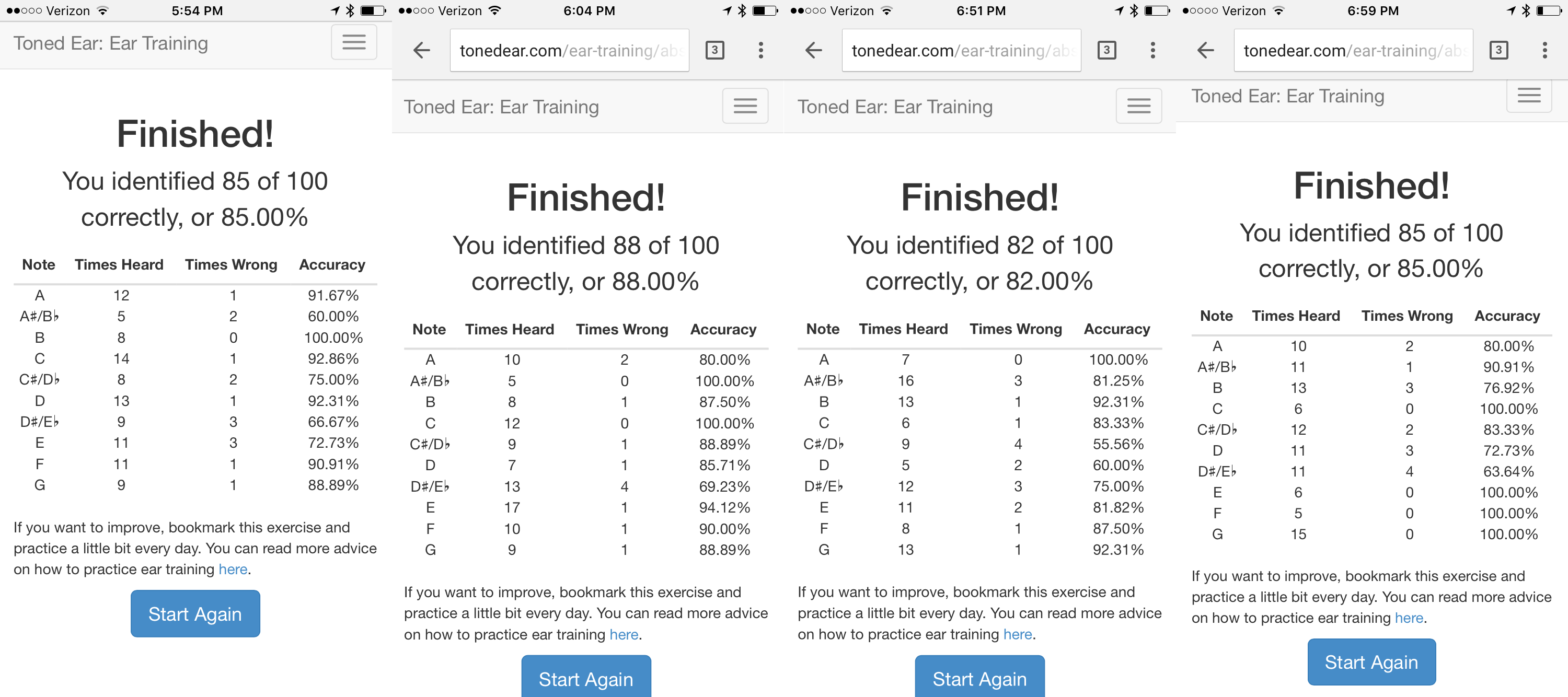
Then, in my final session of the day, I slowed down my approach a bit and scored a 92%, which also featured a run of 52 consecutive correctly-identified notes.
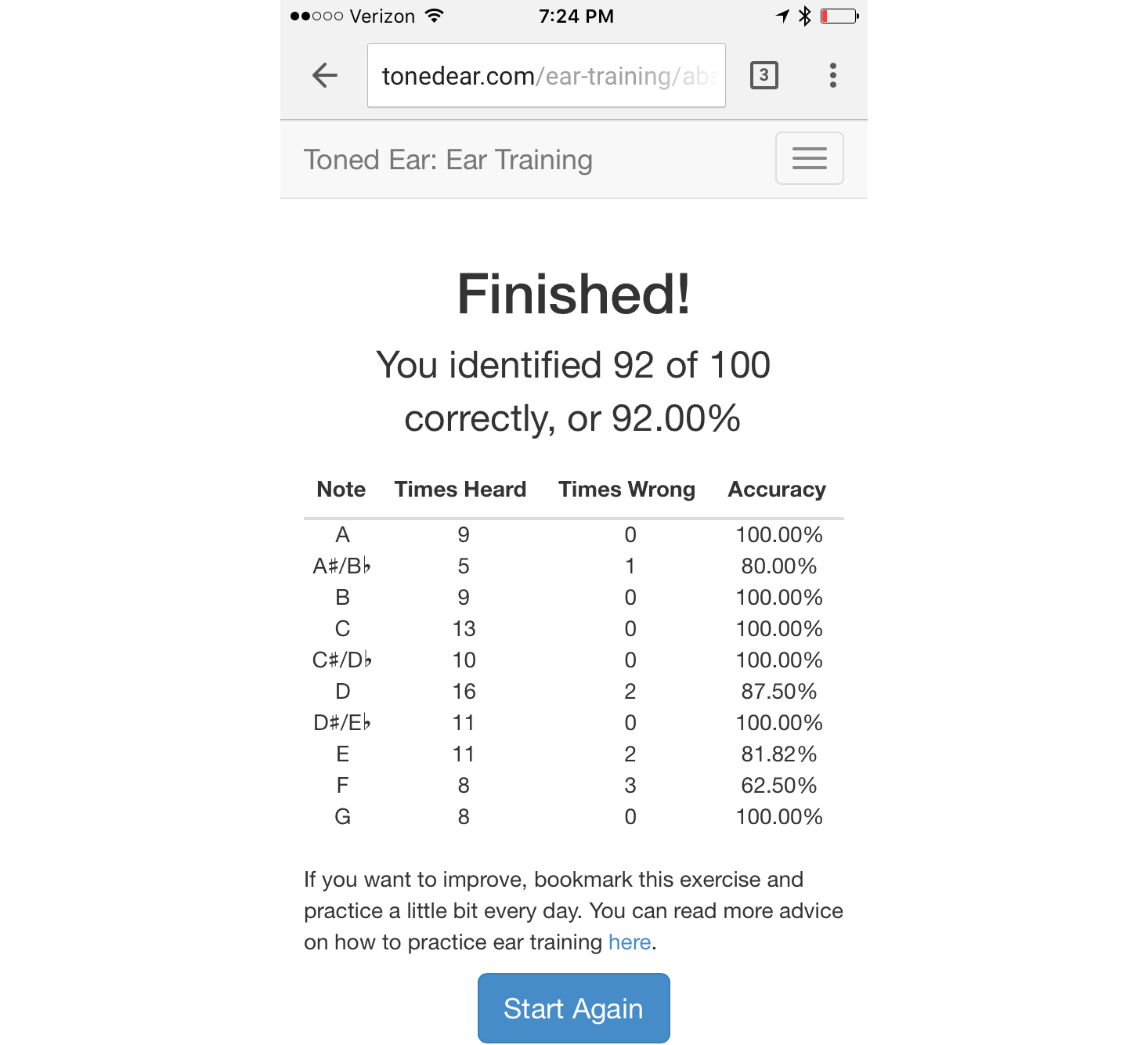
In order to stay on track with my plan, I?ll need to score in the high-90?s tomorrow, and 100% by Tuesday night (for 10 notes? After which, I?ll add in the 11th note, and then finally, the 12th note).
Today was the first day that I really standardized my practicing (into these blocks of 100 notes). Previously, I would identify some arbitrary number of notes, and then stop once I was bored or frustrated.
Transitioning into this more rigorous model definitely helped me remain focused and competitive with myself, as well as more easily track my progress.
I?m honestly not sure why I didn?t introduce this model sooner. I feel like I was a bit too loose in my approach for the past two weeks, and probably could have built up more momentum if I had created structure earlier.
Nevertheless, I?m on a solid, measurable track now, so, as long as my brain can keep up with the program, I should have a shot at this.

Yesterday, I tested myself on 500 notes (across five 100-note sessions) and correctly identified 86.4%, where the eligible notes included C, Db, D, Eb, E, F, G, A, Bb, B.
Today, on the same grouping of ten notes, I tested myself on 400 notes (across four 100-note sessions) and correctly identified 92.5%, scoring my maximum of 94 twice.

A few interesting observations from today:
- I always correctly identify the first note of the session. In other words, when I?m completely cold, my hit rate is 100%. In fact, throughout the day, I test this ability, even when I don?t have time to complete a full 100-note session, and succeed every time. Thus, the mistakes I make are always caused by a confusing combination of notes shifting my reference frame.
- If I get confused, I just need to take a short break. Sometimes, I?ll hear a note in the middle of the session, and can?t decide if it?s an Eb or an E, or it?s a C or C#, etc. In theses case, if I mentally count to ten, this is enough time to let my brain reset and approach the note as if it?s the first in the session.
- My instinct is almost always right. During today?s sessions, I would almost always correctly identify the first 50 notes. Then, I would get nervous, and try to proceed more cautiously, carefully considering each note. The problem is? I tend to overthink it. For example, I may hear a note and my brain will instantly think: ?Okay, that?s an E?. But then, I?ll think: ?Well? Maybe my reference frame is screwed up and it?s actually an Eb?. Finally, I?ll talk myself into guessing Eb, only to find out that the note was an E all along.
- Going slow helps me, but also confuses me. Putting bullet points #2 and #3 together, I?m stuck in a bit of a paradox. Sometimes, a slow deliberate approach helps me, but other times, it forces me to override my instinct (which is almost always correct). For now, I will continue training with as little break as possible, forcing myself to practice my reference tone maintenance.
- Closing the gap between 94% and 100% isn?t worth it. To reduce my mistakes any further, I would likely focus more on my test taking techniques and less on my actual perfect pitch abilities. So instead, I plan to add the eleventh note (Ab) to tomorrow?s sessions. It?s one day early, but I?m ready. I can always focus on optimizing my test taking abilities at the end of the month, if needed.

Today, I added in a new note ? the eleventh note, Ab ? to my training.
As a result, I correctly identified only 80% of the notes over 600 iterations (a drop from yesterday?s 92% average over 400 iterations). Clearly, the introduction of Ab has disrupted my mental tonal stability ? more than I actually expected.

Nevertheless, with some practice over the next three days, I should be able to raise my performance back into the 90?95% range.
Until then, I?d like to share a quick observation about my training in general: I?ve completely abandoned half of my original plan.
Originally, I thought I would need to train in two parts: 1. Develop relative pitch, and 2. Separately develop a consistent mental reference frame.
For #2, I planned on listening to one song over and over again until I could sing it consistently in the correct key. Then, I?d use this information to set my reference frame.
But the truth is? I haven?t listened to that song in over ten days.
Instead, just by training on Toned Ear, with a bias towards the key of C (i.e. starting just with the notes in C, and then slowly adding in the remaining notes), I?ve developed a highly reliable mental reference frame in C.
I don?t even need to think about it: When the first note plays, my brain automatically prepares itself, and interprets the note in the key of C without any conscious assistance on my part. It?s pretty cool.
The song definitely helped get me going, but, if I were to start the month over, knowing what I know now, I wouldn?t bother with the song at all.
Anyway, I?m glad my brain is making this easier than expected. Hopefully, my brain continues to cooperate, even as I slowly remove the bias towards C during my training sessions (since I?ve almost added back all the notes).

I didn?t have much time to practice today.
This morning, I woke up, launched the ?Month to Master? app, and then went out for the rest of the day.
Throughout the day, I tried to sneak in a few quick practice sessions, but I couldn?t get into the rhythm: My accuracy was around 50% at best.
I?m not sure if I was rushing or preoccupied, but my brain wasn?t cooperating. Perhaps, I just underestimated the difference in difficulty level between 10 notes and 11 notes?
Right before I sat down to write this post and admit defeat, I decided to try one more time.
With full concentration and a deliberate pace, I was able to successfully identify 87% of the notes (an improvement over yesterday?s 80% average).

Clearly, if I want to push my perfect pitch skills forward, I need to treat my training less like a casual game. If I?m not fully focused on the task (and instead just going through the motions), I?m essentially wasting my time.
Hopefully, tomorrow, I?ll find some dedicated time for fully focused training.

Yesterday, I rushed through my practice, mostly just going through the motions. My poor performance reflected this.
Today, I had plenty of time to take an unrushed, thoughtful approach to my training, and it definitely paid off.
After warming up, I started my first 100-note session (across 11 out of the 12 notes), and scored my personal best of 95%.
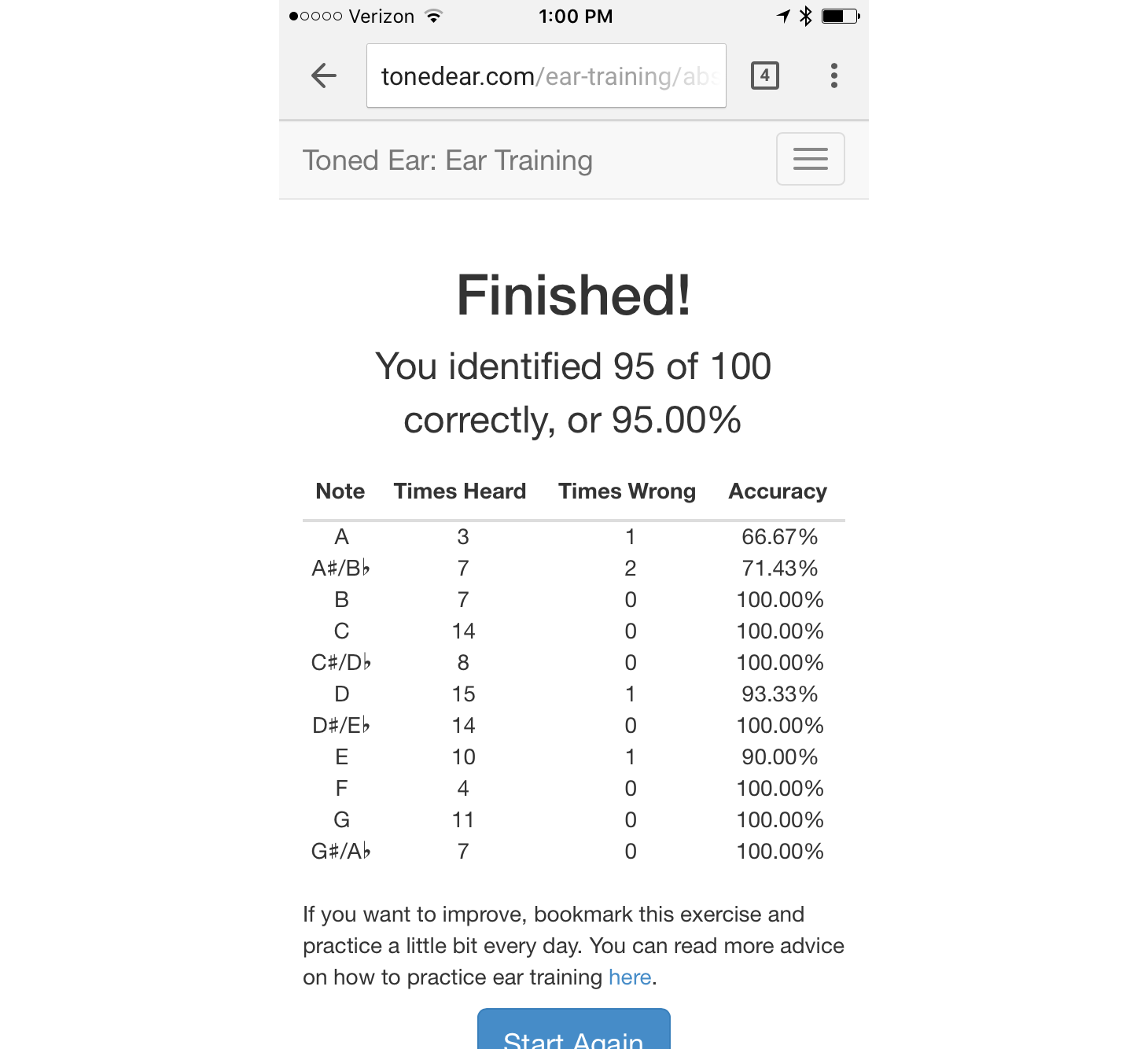
This 95% performance was slightly aided though: After each note played, I softly hummed the resolve back to C, which allowed me to easily maintain my reference frame throughout the entire session.
Last week, I made the decision to stop humming as part of my practice, as I figured this crutch would prevent my brain from fully absorbing the lessons.
However, today, I found out that this wasn?t exactly the right conclusion/decision: Humming the resolves as part of my training actually helps my brain more quickly learn to hear notes within an unwavering context.
After training with humming for a while, I was able to comfortably transition to ?humming? in my head (i.e. not out loud). And then, I was able to stop consciously ?brain humming? all together, instead allowing my brain to naturally understand the notes in the correct context.
At the end of this hum-based progression, I was able to score 90% on another 100-note session without any audible humming or extra mental support.
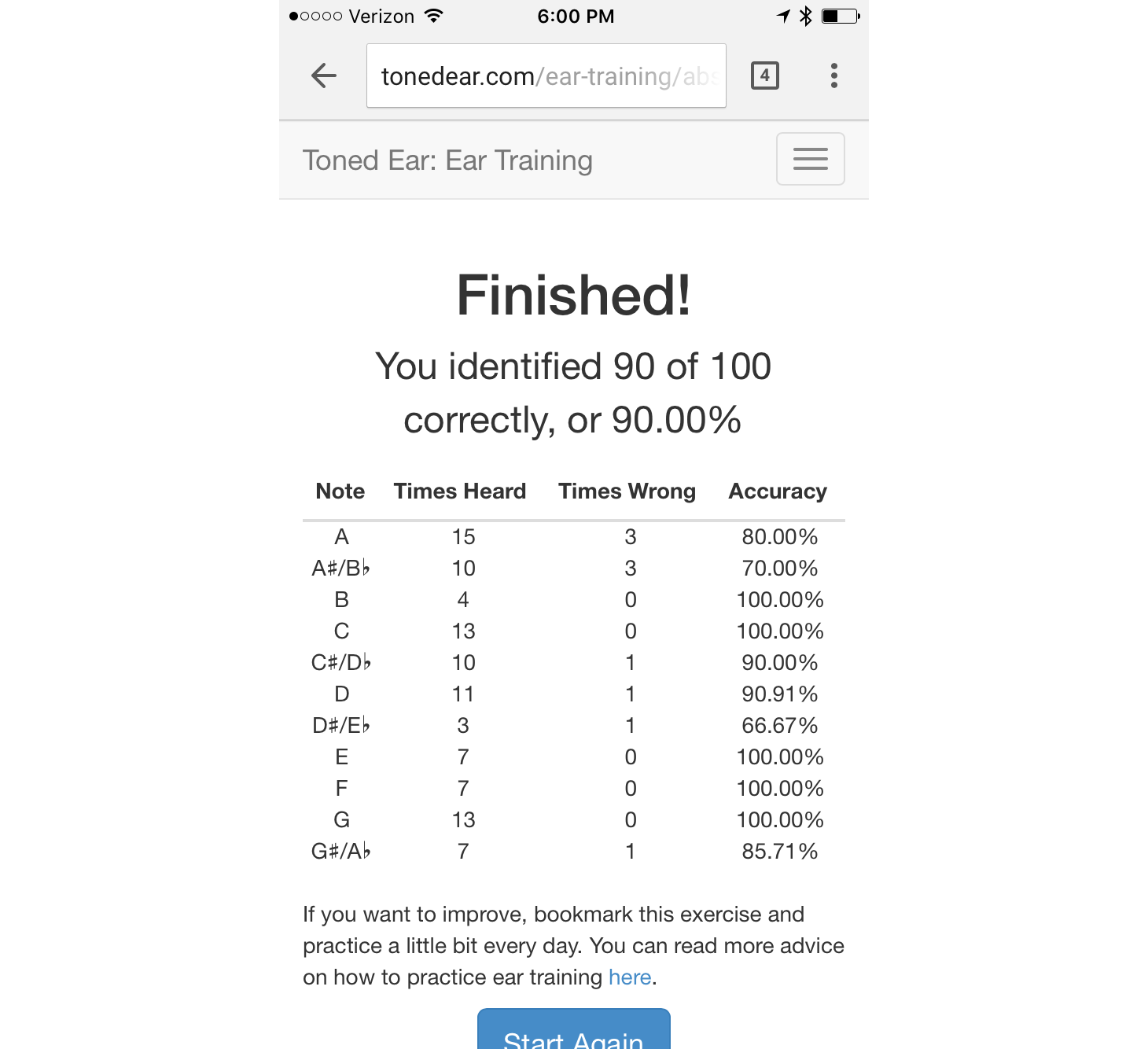
I plan to use this humming progression as my warm-up every day for the rest of the month, which I think will really help me.
Yesterday, I wasn?t sure if I?d be able to progress past eleven notes this month, so I?m glad I let myself experiment a bit today: I see a path forward, with the humming progression as an important part of it.

Yesterday, I discovered the humming progression (a better way to train), which works as follows:
- During the first session of the day, after each note, audibly hum the resolve back to C.
- During the second session of the day, after each note, mentally ?hum? the resolve back to C.
- During the third session of the day, after each note, pause, allowing the brain to subconsciously resolve back to C.
As I mentioned yesterday, this is how I plan to train for the rest of the month (or at least for the next few days).
Today, during the first phase of the humming progression, I correctly identified 92% of the notes. Interestingly, the eight notes I missed were all in the last 30 notes of the session.
In other words, I correctly identified the first 70 notes in a row, before I started to fatigue. But, once I started to fatigue, I just couldn?t maintain the necessary level of concentration.
In fact, because Phase 1 of the humming progression requires a particularly deliberate approach, this first 100-note session took me about 20 minutes to complete. Maintaining complete concentration and intensity for 20 straight minutes turns out to be very mentally taxing.
By the end, I basically just wanted to go to sleep. (Side note: Last week, when I was in California practicing during my morning commutes, my training did put me to sleep a few times).
Hopefully, this desire to sleep at the end of each training session is a sign that I?m optimally engaging my brain in the training.
Or, maybe it just means that I?m tired. (To be fair? I practiced my perfect pitch today immediately after I got home from a 21-mile bike ride, so my body already wanted to relax.)
Either way, if I keep dedicating ~30 minutes daily to this kind of intense practice for the next week, I should be able to complete this month?s challenge before the month ends. It?s going to be close.

Almost two weeks ago, through some sort of fluke, I was able to identify 17 out of 20 chromatic notes (?chromatic? = all twelve notes).
Even though, at the time, this performance wasn?t repeatable, I started comparing my other performances to this new, unrealistic baseline. As a result, over the new few days, I made little progress, lost motivation, and built up a bit of frustration.
Ultimately, I prematurely rushed my training.
A few days later, after realizing this mistake, I reset and began training in a more systematic fashion: I returned to only training on 9 out of the 12 notes, and then I slowly added one incremental note each time I demonstrated consistent performance at the current level.
Today, after incrementing the number of notes a few times over the past week, I added the twelfth and final note, F#.
After warming up using the humming progression, I tested myself on a group of 20 chromatic notes. And, like two weeks ago, I correctly identified 17.

However, this time, my 85% performance is built on a steady, consistent foundation, which means I can finally train at this level in a productive way.

Today, I was out for most of the day with my family. But, I did have a little time to practice this morning.
After warming up and finding my rhythm, I tested myself again on a group of 20 chromatic notes, successfully identifying 19 of them. In other words, I was one note away from completing this month?s challenge (of correctly identifying 20 consecutive, randomly-generated musical notes).
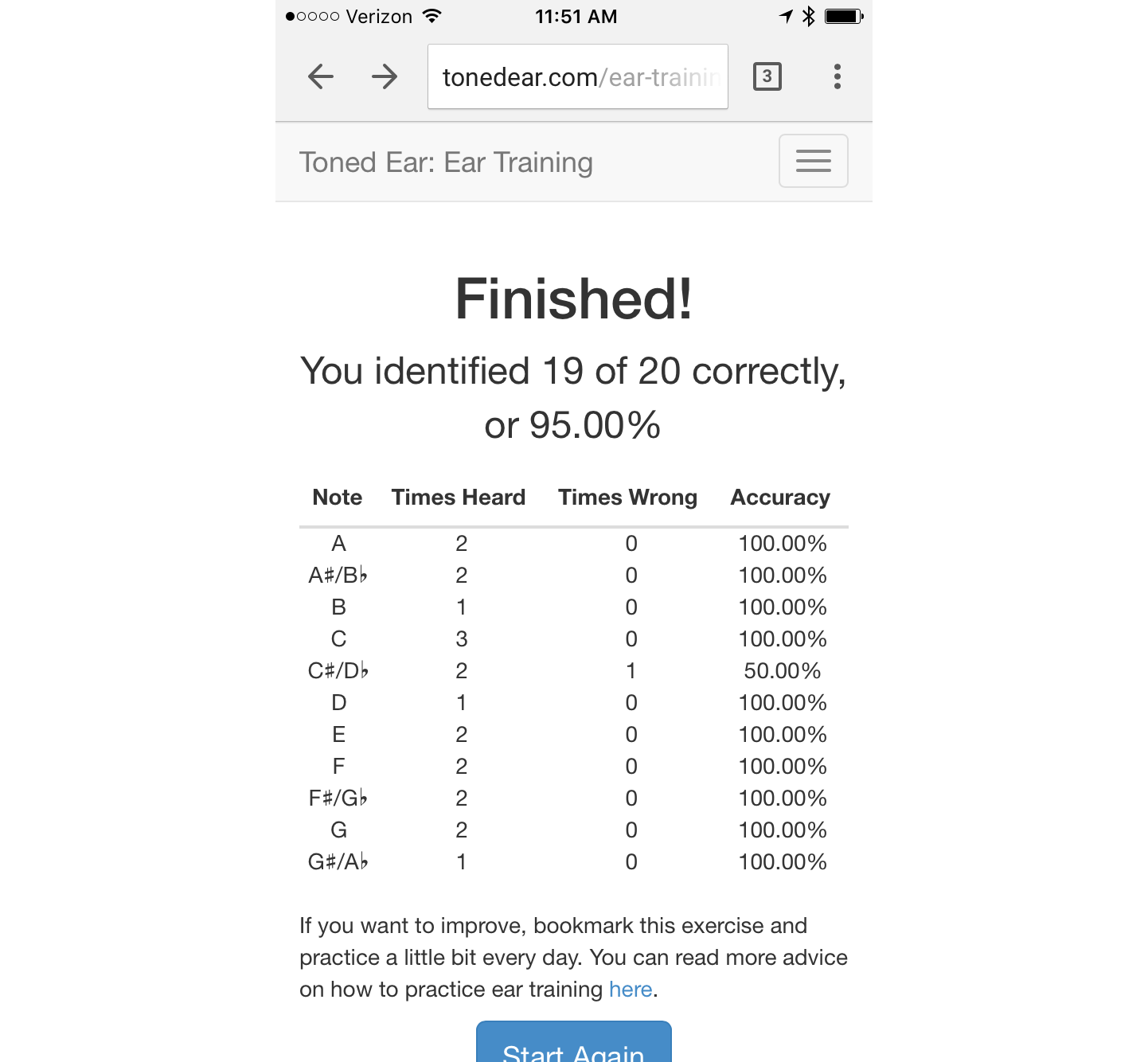
While I?m getting awfully close to my perfect pitch goal (at least, how I defined it), it?s less clear how close I am to genuine perfect pitch:
I?m still pausing for a second or two between each note to minimize the influence of the previous note on my perception of the next. Of course, if I had genuine perfect pitch, this wouldn?t really be a consideration.
Nevertheless, over the past few days, I?ve found that my brain?s ability to be influenced has been slowly declining ? so, if the trend continues, by the end of the week, I may demonstrate an ability that more closely resembles perfect pitch.

Today, I successfully identified 20 consecutive, randomly-generated musical notes (without any reference).

Since this is exactly how I defined my perfect pitch success criteria, I?ve technically completed this month?s challenge. However, I?m not going to officially declare the challenge complete until I film one of these 100% sessions.
I don?t think it will be too challenging to capture one of these sessions on film though, since it seems that I?m fairly consistent now: After I got home for the night, I completed another 20-note session and again successfully identified all 20 notes.
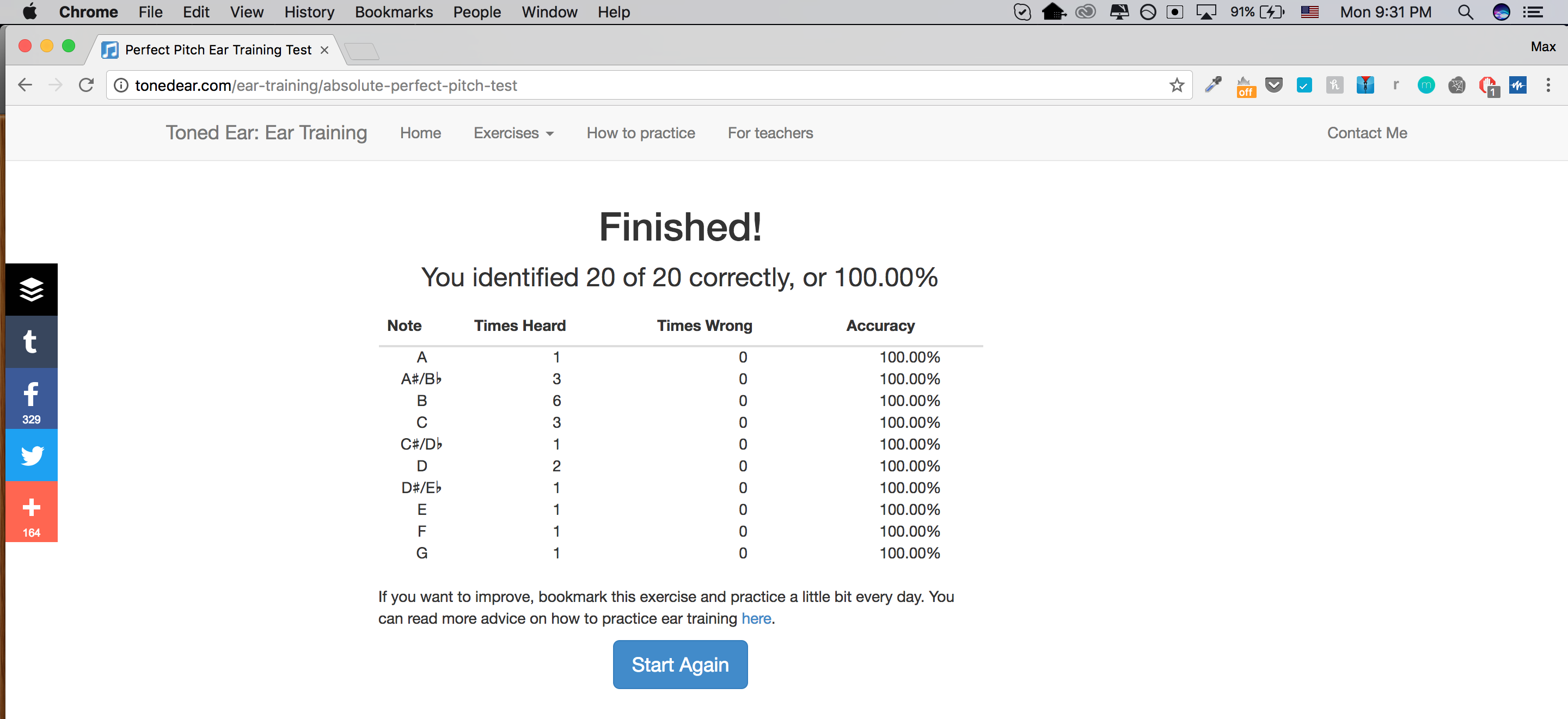
Interestingly, in this second session, I only heard 10 out of the 12 notes, and, in particular, I didn?t hear Ab or F#, even though they were enabled. There?s a 2.6% chance of this happening.
Since these two notes were the last two I added to my training, I theoretically could have identified this sequence of notes last week (when I was practicing with only 10 notes).
In other words, if I was luckier, I could have already completed this month?s challenge. Of course, luck doesn?t really capture the spirit of the challenge (perfect pitch is more about consistency than anything else) ? but it is interesting to consider how luck plays a role:
For example, there?s a 0.3% chance that a 20-note sequence would only feature the notes C, D, Eb, E, F, G, A, Bb, B. Since I could consistently identify these 9 notes two weeks ago, if I had been even luckier, I could have had my perfect 20-note performance then.
Taking things even further, in the first week of practice, I was able to consistently and quickly identify the seven notes in the key of C. Since there?s a 0.002% chance that a 20-note sequence would only feature these notes, with a enough iterations and brute force, I could have even completed the challenge then.
And, of course, if I didn?t practice at all, and just wanted to leave things up to complete luck, I?d have a 0.000000000012% chance of guessing 20 random notes in a row.
So, my success criteria isn?t perfect ? it can be reached with halfway developed skills and excessive effort.
Nevertheless, I?m more interested in actually developing genuine perfect pitch, rather than letting the probabilities occasionally work themselves out, so I?ll continue to focus on consistency and repeatability.

Yesterday, I successfully identified 20 consecutive, randomly-generated musical notes (without any reference). And then, for good measure, I did it again, effectively completing this month?s challenge for a second time.
However, I didn?t want to officially declare the challenge complete, until I caught one of these 20 out of 20 sessions on video, so that?s what I did today. In fact, I decided to film three of these sessions.
Here?s the first?
Here?s the second?
And here?s the third?
Officially, I have now completed this month?s challenge, demonstrating my version of perfect pitch.
I?m not sure if I?m comfortable labelling this ability as genuine perfect pitch (I?ll talk more about this tomorrow), but I?m definitely much closer than I was 27 days ago.

Yesterday, I officially completed this month?s perfect pitch challenge: I successfully identified 20 consecutive, randomly-generated musical notes, without any reference, three times on video.
Even though I completed the challenge, as I defined it, I?m still not sure if I?m comfortable saying that I have perfect pitch.
Firstly, I?m still not ?perfect?. I?ve become much more consistent, but I still make mistakes occasionally.
Also, I don?t recognize all notes immediately, especially if there aren?t any pauses between the notes. In other words, I still find that my interpretation of one note can be influenced by the note I hear before it.
Yet, there are also some indicators that suggest I?m actually closer to having genuine perfect pitch than I think?
Perhaps, most importantly, I always correctly identify the first note of every session. In other words, when there are no other musical sounds or reference points to confuse me, I identify notes with 100% accuracy and immediacy.
I definitely couldn?t do this if I didn?t have some form of perfect pitch.
The problem is that this ?pitch identification in a vacuum? skill becomes less relevant and harder to maintain the deeper I work into a sequence of notes.
Over time, as I progress through a series of notes, my brain shifts from ?perfect pitch?-style identification (of just plucking the note out of the air) to ?relative pitch?-style identification (of comparing the note back to a mental reference tone).
In other words, I actually think I have perfect pitch, but the ability isn?t as dominant in my brain as my relative pitch abilities (which have been trained and synaptically hardened over the past 15 years of musical training). As a result, my relative pitch overpowers my perfect pitch abilities, confusing my brain and messing me up.
Occasionally, in the middle of a session, once my brain is already in relative pitch mode, a note will cut through and I will immediately hear it for what it is. The note bypasses my relative pitch default and finds it?s way to the perfect pitch part of my brain.
I suspect that if I continue to practice and strengthen my perfect pitch abilities, I could eventually overpower my brain?s relative pitch default and maintain genuine perfect pitch deep into a sequence of notes.
This month, because I had the 30-day deadline, I probably relied a little too heavily on my brain?s relative pitch skills to succeed. Thus, if I actually wanted to make my perfect pitch abilities dominant, I?d need to rethink my training and try to isolate just the perfect pitch components of the exercise.
Anyway, perhaps I do have perfect pitch, but it?s still only a quiet signal in my brain, getting suffocated by many stronger, more deeply engrained signals.
I?m not sure if this counts, but I?d like to think it does. And if not, at least my progress suggests that an adult could feasibly acquire genuine perfect pitch.
Semantics aside, I?ve clearly changed the way my brain perceives pitch, which is pretty cool.

This month, I acquired some lightweight form of perfect pitch, but have only scratched the surface in terms of what?s possible.
In fact, there?s a whole range of skills that fall under the perfect pitch umbrella that I didn?t touch at all: Identifying two notes at a time, three notes at a time, ten notes at a time, etc.; singing notes on command; instantly identifying the key of a song; and so on.
My favorite demonstrations of these kinds of perfect pitch skills are performed by 9-year-old Dylan Biato, who has been trained by musician dad Rick Biato since birth.
Here?s just one of his many perfect pitch videos?
Clearly, I have a long way to go to be at Dylan?s level, but I?m certainly motivated by his abilities. After all, like Dylan (and everyone else), I also have a human brain (which can?t be that different to Dylan?s).
In other words, when I see someone like Dylan who is masterful at his/her craft, it isn?t a reminder of my deficiencies, but a reminder of my potential.

It?s the last day of June, which means it?s time to look back and see just how much time I spent on this month?s challenge.
After going through my practice logs and tallying everything up, here?s what I found: In total, I spent only 16 hours on this month?s challenge, or a little bit more than 35 minutes per day.
Interestingly, although I spent noticeably less time on this challenge versus most of the previous challenges, from a mental exertion standpoint, this challenge likely stands near the top of the leaderboard.
In other words, this challenge demanded less time, but way more intensity on a minute-by-minute basis.
In order to get anything out of my training sessions, I had to consistently max out my brain?s CPU. There was no way to take this challenge at a more leisurely pace.
This is actually an interesting insight?
For the past eight months, at the end of every challenge, I have summarized the month by totaling up the number of hours I practiced. I do this both because I?m curious how much time I spent training and because I think it helps others understand/appreciate what went into each challenge.
But, the time dimension is only half the picture. What I haven?t included in these posts is how I use this time.
There?s a big difference between leisurely practicing something for an hour and maintaining intense concentration for an hour, but this distinction is lost when I just report the total number of hours.
So, this month?s challenge is a good reminder to say: ?It?s usually less about the number of hours that you put in, and more about what you make of those hours?.
Nevertheless, it?s much more difficult to measure effort, so we?ll still have to settle on hours as the most measurable and universally understood proxy.
And so, with hours as the measurement of interest, I must say? For a 16-hour investment, I?m quite happy with the progress I made.
![]()
